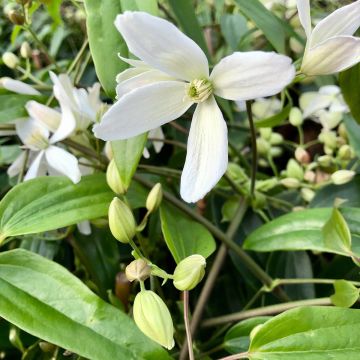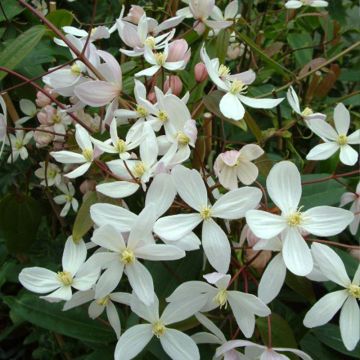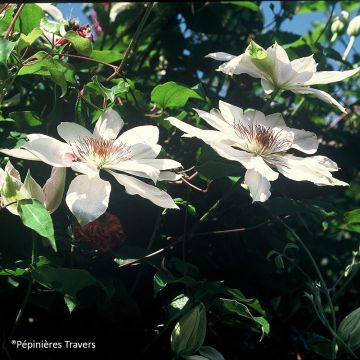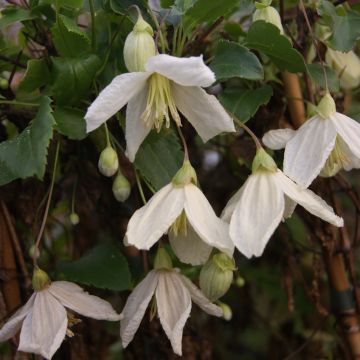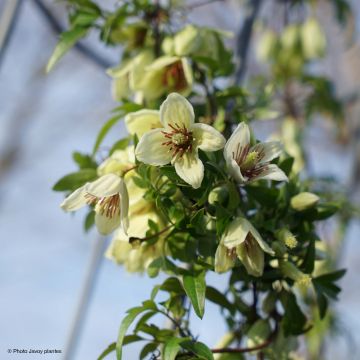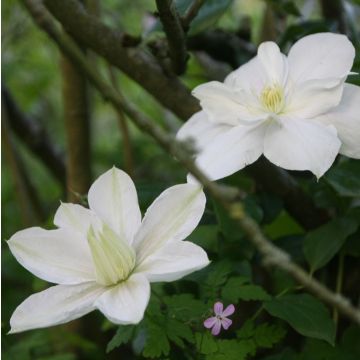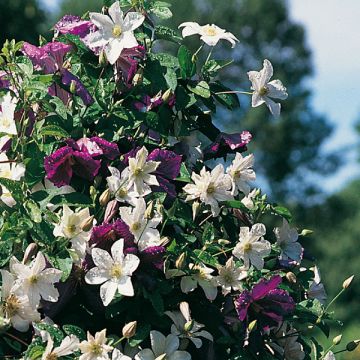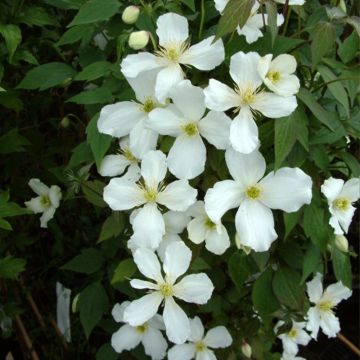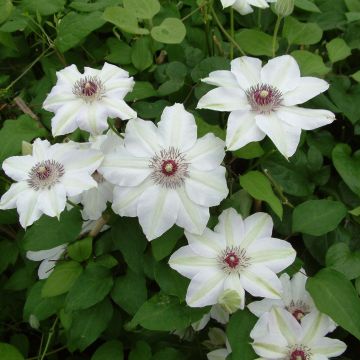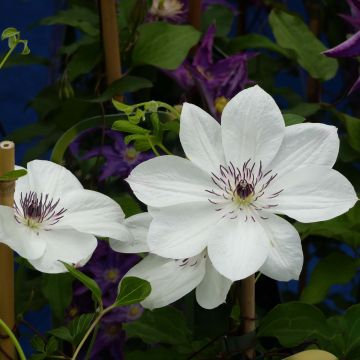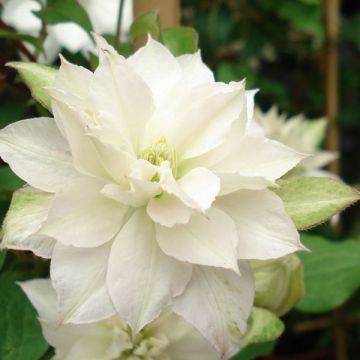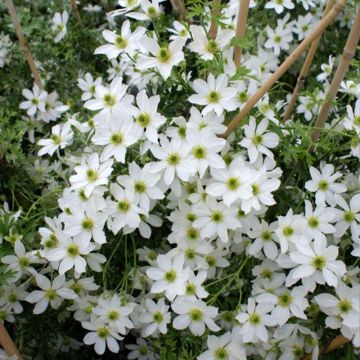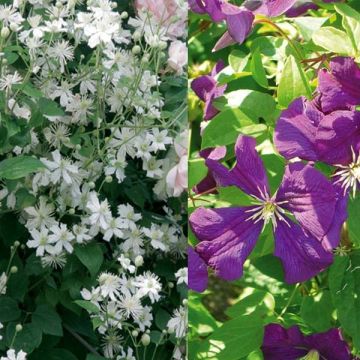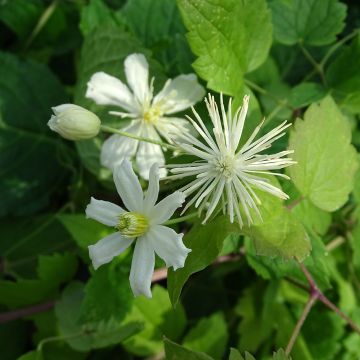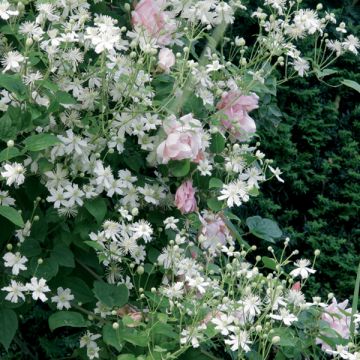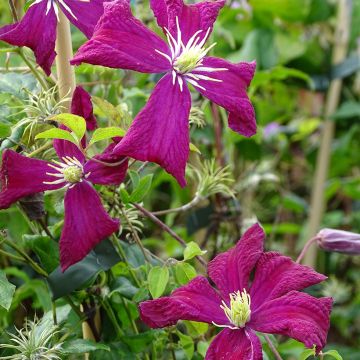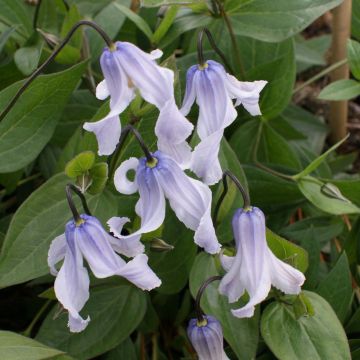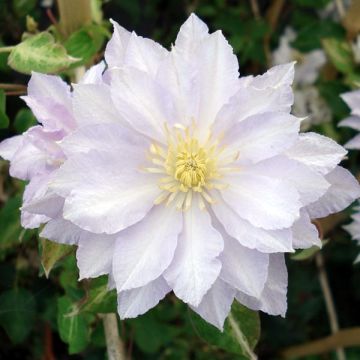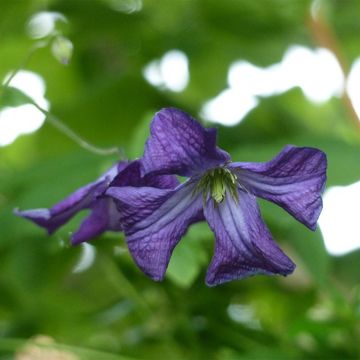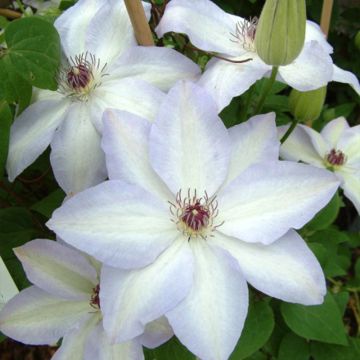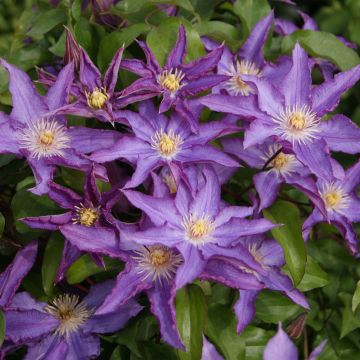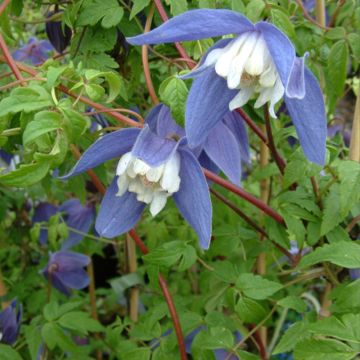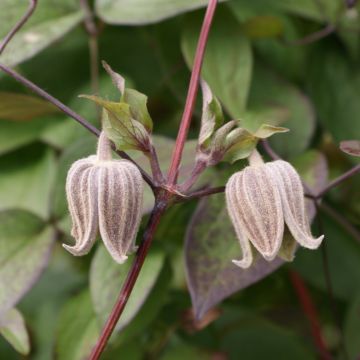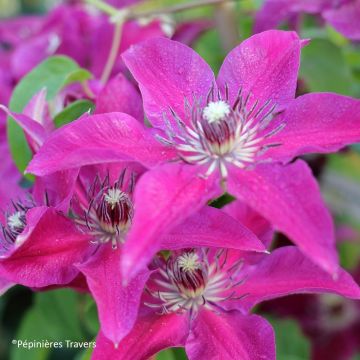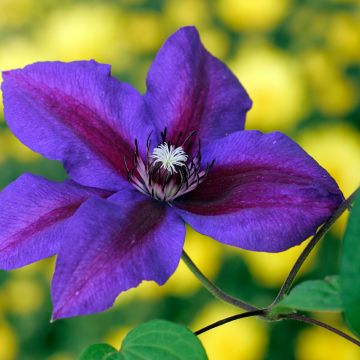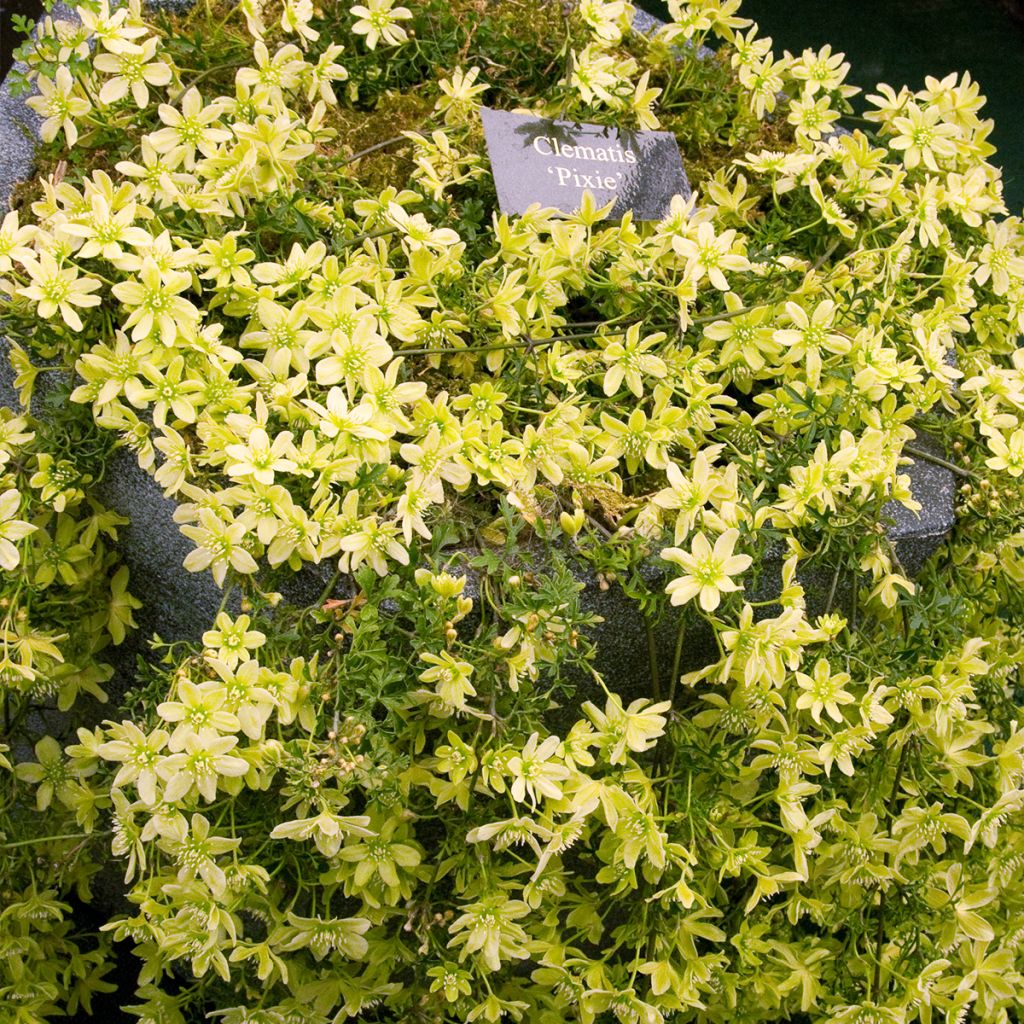

Clematis x cartmanii Pixie
Clematis x cartmanii Pixie
Clematis x cartmanii Pixie
Joe's Clematis, Cartman's Clematis, Forsteri Group Clematis
Why not try an alternative variety in stock?
View all →This plant carries a 6 months recovery warranty
More information
We guarantee the quality of our plants for a full growing cycle, and will replace at our expense any plant that fails to recover under normal climatic and planting conditions.
From €5.90 for pickup delivery and €6.90 for home delivery
Express home delivery from €8.90.
Does this plant fit my garden?
Set up your Plantfit profile →
Description
The Clematis x cartmanii 'Pixie', sometimes called the 'Pixie' Clematis, is a small climbing plant with particularly compact evergreen dark green foliage that is covered in small white flowers with delicately fragrant green throats in spring. Its small size and frost-sensitive nature make it a lovely plant for balconies and terraces, where it can happily overflow from pots.
The Clematis genus belongs to the Ranunculaceae family. The 'Pixie' Clematis is a horticultural variety belonging to the cartmanii hybrid group. These plants are the result of cross-breeding different botanical species native to New Zealand, such as Clematis indivisa, better known as Clematis paniculata, or Clematis forsteri. It is a perennial climbing plant with voluble stems, evergreen, vigorous, and floriferous. It is classified in the group of clematis that flower early in the season on one-year-old shoots. It takes a little time to establish, eventually forming a bushy clump that reaches barely 70 cm (28in) in all directions. Flowering begins in April, earlier or later depending on the climate, and lasts for several weeks. The flowers, clustered together, measure 3 to 4 cm (1 to 2in) in diameter. Their shape resembles that of daisies but with only 6 greenish petals when they open, becoming whiter at full bloom. The centre of the corolla, light green in colour, is occupied by pale yellow stamens with white anthers. The flowering is followed by the formation of silvery, feathery fruits in decorative helix shapes. The light, evergreen foliage is composed of thick, finely cut leaves that are bright and glossy green.
Clematis (x) cartmanii like 'Pixie' are sensitive to frost and also dislike dry soils. It will not survive below -5°C. Although capable of climbing a support, it will be much more beautiful when allowed to roam freely, weaving through neighbouring plants or trailing over low bushes in favourable climates, for example in Breton gardens. Cartmanii clematis are excellent plants for terraces or balconies in cold regions. Let them cascade from a large container: the foliage, flowers, and fruits will provide a magnificent display throughout the growing season. These clematis will rest in winter in a lightly heated conservatory.
Report an error about the product description
Clematis x cartmanii Pixie in pictures
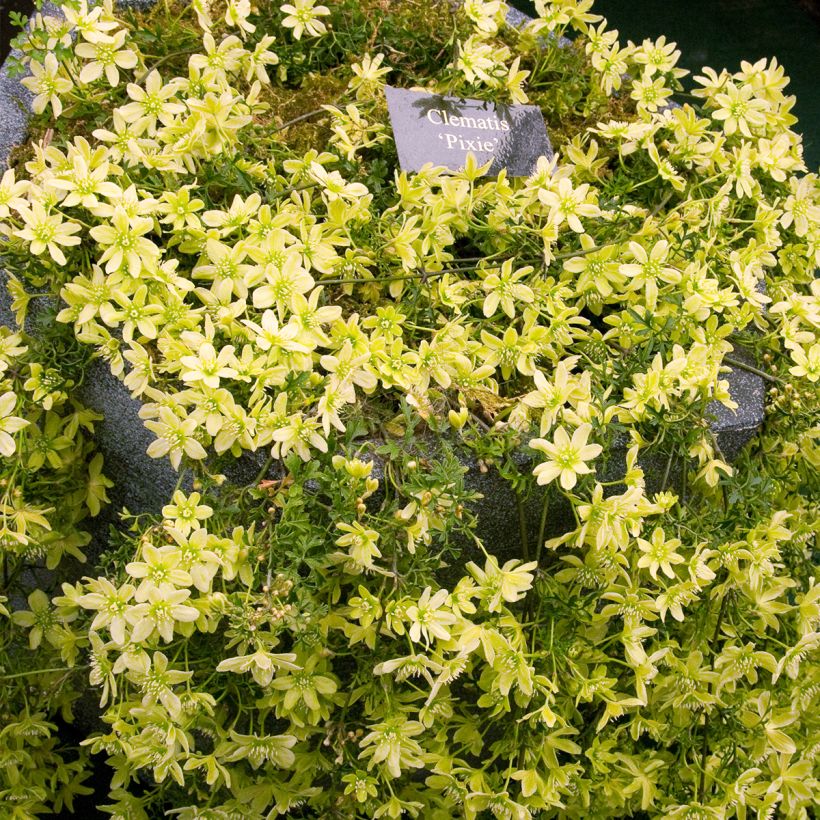

Plant habit
Flowering
Foliage
Botanical data
Clematis
x cartmanii
Pixie
Ranunculaceae
Joe's Clematis, Cartman's Clematis, Forsteri Group Clematis
Cultivar or hybrid
Other Clematis A to Z
Planting and care
This variety of 'Pixie' clematis requires a mild climate, a moist soil, and a very sunny exposure to thrive fully. Its hardiness does not exceed -5 °C in open ground, in a sheltered position. It prefers a light, humus-rich soil, not too dry but moist and well-drained. Mulch the plant with garden compost or well-decomposed manure, avoiding direct contact with the stems. Cover the base of climbing clematis with a 3 cm (1in) mound of soil or another plant like a ground cover or a perennial geranium. It is a plant that likes to have its feet cool. Water heavily and regularly during the first few weeks. It does not require any particular pruning due to its slow growth and early flowering. Clematis plants cling to their support on their own. To help them grow, provide them with a trellis support or let them dress the trunk of a tree by placing a wire mesh around it. Clematis also enjoy growing freely on neighboring plants. There may be wilting of the clematis in moist soil. Voles and grey worms devour young shoots. Aphids can also attack young plants. In a greenhouse, whiteflies should be watched out for.
Planting period
Intended location
Care
This item has not been reviewed yet - be the first to leave a review about it.
Clematis
Haven't found what you were looking for?
Hardiness is the lowest winter temperature a plant can endure without suffering serious damage or even dying. However, hardiness is affected by location (a sheltered area, such as a patio), protection (winter cover) and soil type (hardiness is improved by well-drained soil).

Photo Sharing Terms & Conditions
In order to encourage gardeners to interact and share their experiences, Promesse de fleurs offers various media enabling content to be uploaded onto its Site - in particular via the ‘Photo sharing’ module.
The User agrees to refrain from:
- Posting any content that is illegal, prejudicial, insulting, racist, inciteful to hatred, revisionist, contrary to public decency, that infringes on privacy or on the privacy rights of third parties, in particular the publicity rights of persons and goods, intellectual property rights, or the right to privacy.
- Submitting content on behalf of a third party;
- Impersonate the identity of a third party and/or publish any personal information about a third party;
In general, the User undertakes to refrain from any unethical behaviour.
All Content (in particular text, comments, files, images, photos, videos, creative works, etc.), which may be subject to property or intellectual property rights, image or other private rights, shall remain the property of the User, subject to the limited rights granted by the terms of the licence granted by Promesse de fleurs as stated below. Users are at liberty to publish or not to publish such Content on the Site, notably via the ‘Photo Sharing’ facility, and accept that this Content shall be made public and freely accessible, notably on the Internet.
Users further acknowledge, undertake to have ,and guarantee that they hold all necessary rights and permissions to publish such material on the Site, in particular with regard to the legislation in force pertaining to any privacy, property, intellectual property, image, or contractual rights, or rights of any other nature. By publishing such Content on the Site, Users acknowledge accepting full liability as publishers of the Content within the meaning of the law, and grant Promesse de fleurs, free of charge, an inclusive, worldwide licence for the said Content for the entire duration of its publication, including all reproduction, representation, up/downloading, displaying, performing, transmission, and storage rights.
Users also grant permission for their name to be linked to the Content and accept that this link may not always be made available.
By engaging in posting material, Users consent to their Content becoming automatically accessible on the Internet, in particular on other sites and/or blogs and/or web pages of the Promesse de fleurs site, including in particular social pages and the Promesse de fleurs catalogue.
Users may secure the removal of entrusted content free of charge by issuing a simple request via our contact form.
The flowering period indicated on our website applies to countries and regions located in USDA zone 8 (France, the United Kingdom, Ireland, the Netherlands, etc.)
It will vary according to where you live:
- In zones 9 to 10 (Italy, Spain, Greece, etc.), flowering will occur about 2 to 4 weeks earlier.
- In zones 6 to 7 (Germany, Poland, Slovenia, and lower mountainous regions), flowering will be delayed by 2 to 3 weeks.
- In zone 5 (Central Europe, Scandinavia), blooming will be delayed by 3 to 5 weeks.
In temperate climates, pruning of spring-flowering shrubs (forsythia, spireas, etc.) should be done just after flowering.
Pruning of summer-flowering shrubs (Indian Lilac, Perovskia, etc.) can be done in winter or spring.
In cold regions as well as with frost-sensitive plants, avoid pruning too early when severe frosts may still occur.
The planting period indicated on our website applies to countries and regions located in USDA zone 8 (France, United Kingdom, Ireland, Netherlands).
It will vary according to where you live:
- In Mediterranean zones (Marseille, Madrid, Milan, etc.), autumn and winter are the best planting periods.
- In continental zones (Strasbourg, Munich, Vienna, etc.), delay planting by 2 to 3 weeks in spring and bring it forward by 2 to 4 weeks in autumn.
- In mountainous regions (the Alps, Pyrenees, Carpathians, etc.), it is best to plant in late spring (May-June) or late summer (August-September).
The harvesting period indicated on our website applies to countries and regions in USDA zone 8 (France, England, Ireland, the Netherlands).
In colder areas (Scandinavia, Poland, Austria...) fruit and vegetable harvests are likely to be delayed by 3-4 weeks.
In warmer areas (Italy, Spain, Greece, etc.), harvesting will probably take place earlier, depending on weather conditions.
The sowing periods indicated on our website apply to countries and regions within USDA Zone 8 (France, UK, Ireland, Netherlands).
In colder areas (Scandinavia, Poland, Austria...), delay any outdoor sowing by 3-4 weeks, or sow under glass.
In warmer climes (Italy, Spain, Greece, etc.), bring outdoor sowing forward by a few weeks.

































